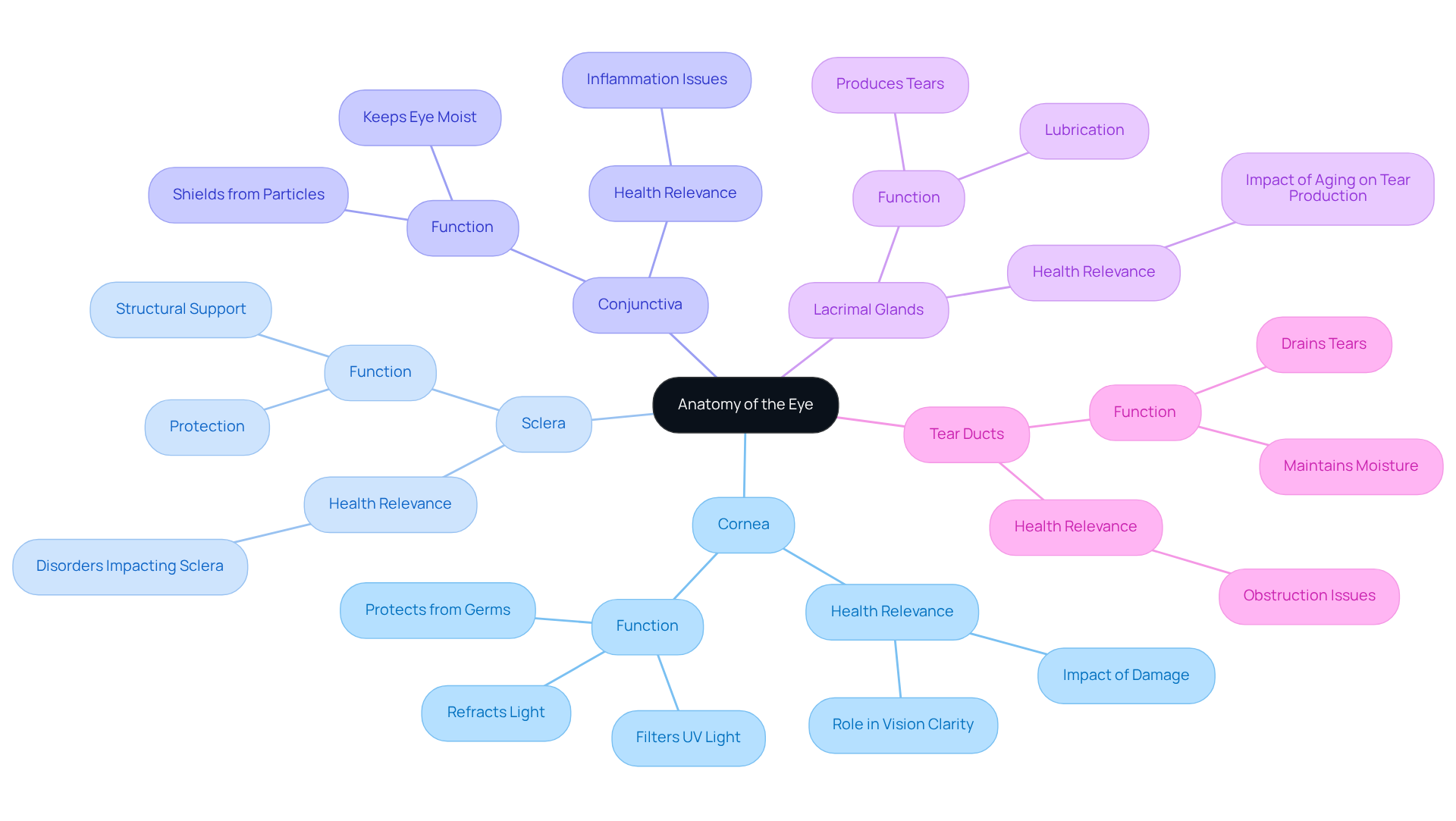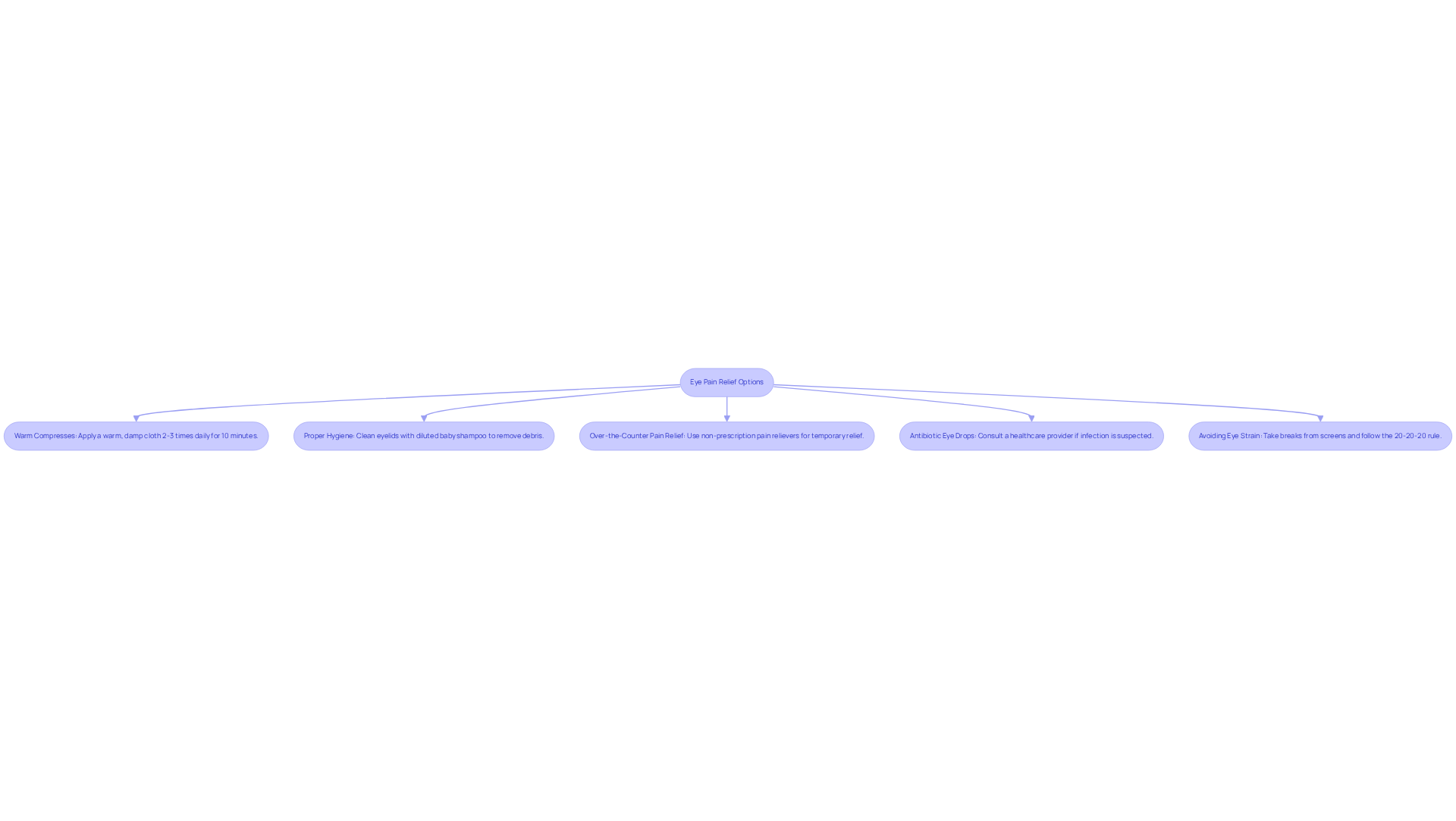Posted by: Northwest Eye in General on November 16, 2025
Introduction
Experiencing discomfort in the inner corner of your eye can be alarming and confusing. We understand that this sensation often signals underlying issues that deserve your attention. In this article, we’ll explore the delicate anatomy of the eye, shedding light on the various structures that might contribute to pain in this sensitive area.
You’re not alone in feeling this way. Many people experience discomfort for a variety of reasons, from infections to foreign bodies. We’ll provide insights into these common causes, along with effective remedies and treatment options to help alleviate your symptoms.
What strategies can you employ to navigate this complex landscape of eye health? It’s common to feel overwhelmed, but we are here to help you through this process. Together, we’ll find the relief you deserve.
Explore the Anatomy of the Eye and Its Pain Points
The eye is a remarkable organ, made up of several essential structures that play a vital role in our vision and overall eye health. We understand that concerns about eye discomfort can be unsettling, so let’s take a closer look at these key components:
- Cornea: This transparent front layer refracts light, helping to focus images onto the retina. It also filters harmful UV light from the sun and protects the eye from germs and bacteria, making it crucial for maintaining eye health.
- Sclera: The tough, white outer layer provides structural support and protection to the eye, ensuring it remains safe and secure.
- Conjunctiva: A delicate membrane that covers the sclera and lines the eyelids, it helps keep the eye moist and shields it from foreign particles.
- Lacrimal Glands: These glands produce tears, which are essential for lubrication and protecting the eye against pathogens.
- Tear Ducts: Channels that drain tears from the eye into the nasal cavity, helping to maintain moisture.
It’s common to feel pain in the inner corner of the eye, which is often linked to issues involving these structures, such as inflammation or infection of the tear ducts or conjunctiva. Recent research indicates that conditions like conjunctivitis and obstructed tear ducts frequently lead to pain in the inner corner of the eye. Understanding the anatomy of the eye not only helps identify the source of discomfort but also guides effective treatment strategies.
For instance, case studies have shown that addressing inflammation in the conjunctiva can significantly alleviate discomfort. This highlights the importance of accurate diagnosis and targeted care. Remember, as Helen Keller once said, “The only thing worse than being blind is having sight but no vision.” This emphasizes how crucial eye health is for our overall well-being. We are here to help you through this process, ensuring you receive the care and support you need.

Identify Common Causes of Pain in the Inner Corner of the Eye
Experiencing a pain in the inner corner of your eye can be concerning, and it’s important to understand that various issues can lead to this pain, each with its own symptoms and treatment options. Here are some key causes:
-
Dacryocystitis: This condition involves an infection of the tear sac, which can cause significant swelling, redness, and pain. You might notice discharge from the inner corner of your eye, along with a possible fever. Treatment typically involves antibiotics, and in some cases, surgery may be necessary to restore normal tear drainage.
-
Blepharitis: If you’re feeling irritation and crusting along your eyelid margins, it could be blepharitis. This inflammation is often linked to seborrheic dermatitis or bacterial infections. Managing this condition usually involves maintaining proper eyelid hygiene, and sometimes, antibiotic ointments can help.
-
Styes (Hordeolum): These painful lumps on the eyelid are caused by blocked oil glands, leading to localized swelling and tenderness. Warm compresses can provide relief, and if the stye doesn’t improve, medical treatment may be needed.
-
Conjunctivitis: If you notice redness, tearing, and discomfort, conjunctivitis might be the culprit. This inflammation of the conjunctiva can be triggered by infections, allergies, or irritants. Treatment varies based on the cause, with options like antihistamines for allergic conjunctivitis or antibiotics for bacterial cases.
-
Foreign Bodies: If something gets trapped in your eye, it can cause acute pain and irritation. It’s crucial to seek immediate medical attention to safely remove the object and prevent further injury.
We understand that navigating these conditions can be overwhelming. Recognizing these symptoms is essential for deciding the right course of action, whether that means trying home remedies or seeking professional medical care. Remember, prompt attention can help prevent complications and ensure effective management. We are here to help you through this process.

Implement Effective Remedies and Treatment Options for Eye Pain
We understand how concerning it can be to alleviate pain in the inner corner of your eye. Here are some remedies and treatment options that may help you find relief:
-
Warm Compresses: Applying a warm, damp cloth to the affected area can significantly reduce inflammation and promote drainage, especially if there’s an infection. We recommend using a warm compress 2 to 3 times daily for optimal relief. Just be sure not to leave it on for more than 10 minutes at a time to avoid skin irritation.
-
Proper Hygiene: Maintaining eyelid hygiene is crucial for managing conditions like blepharitis. Gently cleaning your eyelids with a diluted baby shampoo can help remove debris and prevent further irritation, contributing to improved comfort.
-
Over-the-Counter Pain Relief: Non-prescription pain relievers can effectively manage sensations associated with mild ailments or inflammation, providing temporary relief while addressing the underlying issue.
-
Antibiotic Eye Drops: If you suspect an infection, it’s essential to consult a healthcare provider for appropriate antibiotic treatment. Early intervention can prevent complications and promote faster recovery.
-
Avoiding Eye Strain: Taking regular breaks from screens and ensuring proper lighting can help lessen irritation caused by eye strain. Implementing the 20-20-20 rule-looking at something 20 feet away for 20 seconds every 20 minutes-can be particularly beneficial.
If your symptoms persist or worsen, seeking professional medical advice is crucial to rule out more serious conditions. Remember, we are here to help you through this process, and by adopting these practices, you can enhance your eye health and alleviate discomfort effectively.

Conclusion
Understanding the pain in the inner corner of your eye is crucial for maintaining overall eye health and comfort. We know that experiencing discomfort in this sensitive area can be concerning. By exploring the anatomy of the eye, it becomes clear how various conditions can lead to this pain. Recognizing the underlying causes, such as infections or inflammation, allows for targeted treatment that can significantly alleviate discomfort and improve your quality of life.
Several common conditions can cause inner corner eye pain, including:
- Dacryocystitis
- Blepharitis
- Styes
- Conjunctivitis
- The presence of foreign bodies
Each condition has its own set of symptoms and recommended remedies. It’s important to get a proper diagnosis and treatment. Implementing effective strategies, such as warm compresses, maintaining eyelid hygiene, and seeking professional medical advice when necessary, can lead to significant relief.
Ultimately, prioritizing your eye health is essential for your overall well-being. By understanding the anatomy of your eye and recognizing the symptoms of potential issues, you can take proactive steps toward prevention and treatment. Whether through home remedies or professional care, addressing eye pain promptly can help preserve your vision and enhance your daily comfort. Remember, empowerment through knowledge is key-don’t hesitate to seek help, and ensure your eyes remain healthy and pain-free.
Frequently Asked Questions
What are the main structures of the eye?
The main structures of the eye include the cornea, sclera, conjunctiva, lacrimal glands, and tear ducts. Each of these components plays a vital role in vision and overall eye health.
What is the function of the cornea?
The cornea is the transparent front layer of the eye that refracts light to help focus images onto the retina. It also filters harmful UV light and protects the eye from germs and bacteria.
What role does the sclera play in eye health?
The sclera is the tough, white outer layer of the eye that provides structural support and protection, ensuring the eye remains safe and secure.
How does the conjunctiva contribute to eye health?
The conjunctiva is a delicate membrane that covers the sclera and lines the eyelids, helping to keep the eye moist and shielding it from foreign particles.
What is the function of the lacrimal glands?
The lacrimal glands produce tears, which are essential for lubricating the eye and protecting it against pathogens.
What do tear ducts do?
Tear ducts are channels that drain tears from the eye into the nasal cavity, helping to maintain moisture in the eye.
What can cause pain in the inner corner of the eye?
Pain in the inner corner of the eye is often linked to issues such as inflammation or infection of the tear ducts or conjunctiva, with conditions like conjunctivitis and obstructed tear ducts being common causes.
Why is understanding the anatomy of the eye important?
Understanding the anatomy of the eye helps identify the source of discomfort and guides effective treatment strategies, allowing for accurate diagnosis and targeted care.






